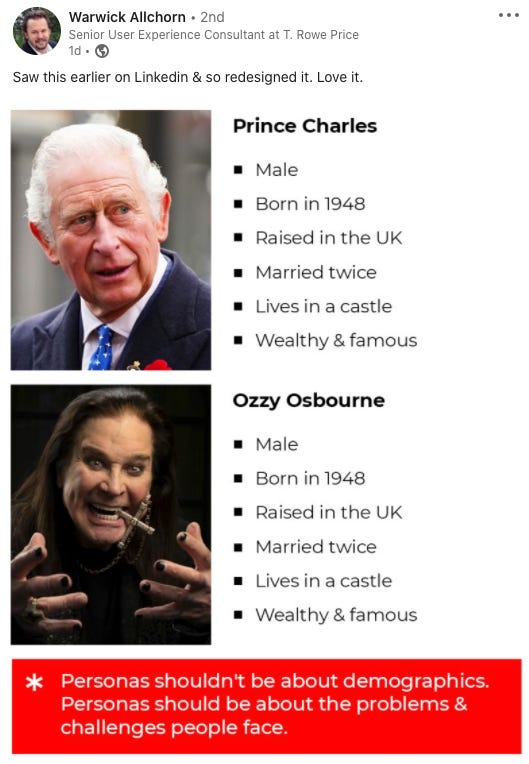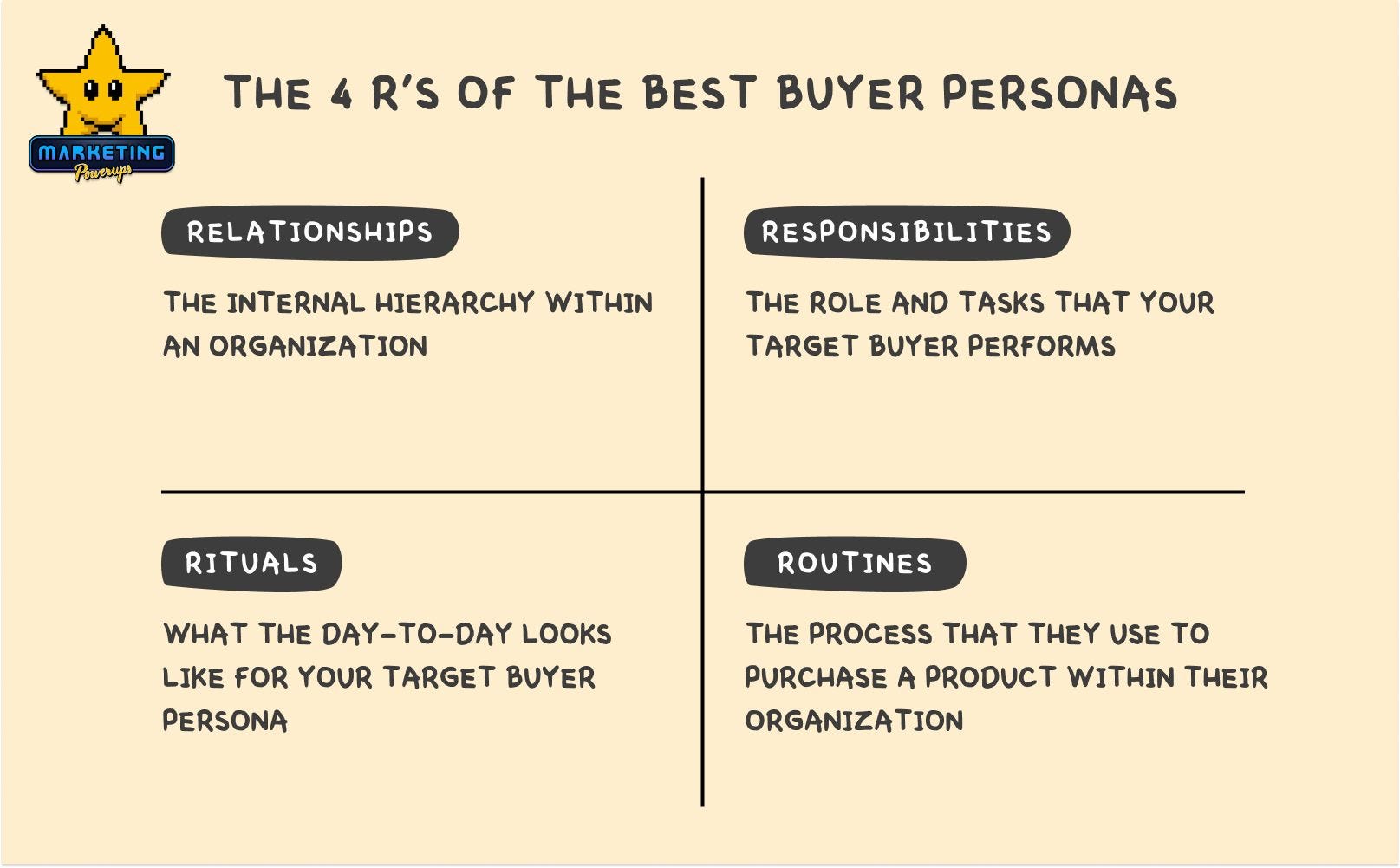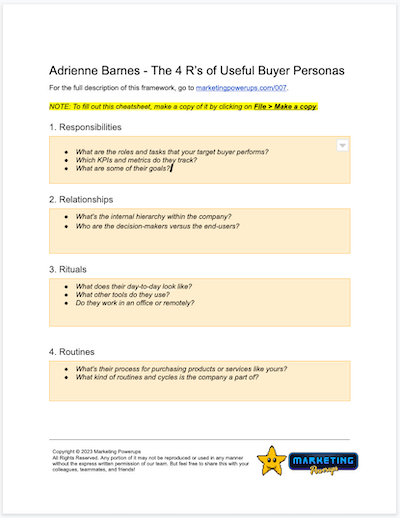Why most buyer personas suck (and how to create useful ones)
Marketing Powerup #22: Five tips to create more actionable and needle-moving buyer personas
Most buyer personas suck. And chances are it’s hurting your marketing.
They typically have a quirky name like “Marketing Mark.”
It has some information like:
- 28 years old.
- Makes $89,000 a year.
- Married with two children.
If your buyer persona has info like this, STOP!
The marketing campaigns you’ve spent weeks pouring your blood, sweat, and tears into could fall flat because of an inaccurate buyer persona.
“How?” You might ask…
Today, I’m going to share the five pitfalls with most buyer personas (and how to fix them.)
You can also watch it now on YouTube.
Before I continue, I want to invite you to subscribe to the Marketing Powerups YouTube channel. You’ll be the first to know about new, value-packed, and entertaining videos that will help power up your marketing.
Pitfall #1: Most buyer personas are based on fiction. 🦄
Most buyer personas are something marketers "makeup" in their heads based on the customers they want.
It’s not based on data, research, or interviews. So it leads to a lot of guessing and a document full of assumptions and generalizations.
Warwick Allchorn highlights this problem with buyer personas:

The point: not all males born in 1948 and raised in the UK are the same. Prince Charles and Ozzy Osbourne are two people who could not be more different.
The problem often is that buyer personas become a fictional representation of the type of customer YOU want.
They should represent which customers your product is speaking to the most.
The solution:
If you want your persona to be "actionable" you must have relevant data.
I'm not talking about Google Analytics because it'll only tell you what your customers are doing, not why.
If you want to know why your customers buy or churn, then you have to ask them.
Focus on the M&M of buyer psychology: mindset and motivation.
- What was happening in their life that triggered them to seek a new solution?
- Why did they pick your product?
- What are their goals?
When you’re able to understand a persona to the point where you know both what their motivation is and their level of urgency in that motivation, you can create content that better shows how you can solve their problems.
Pitfall #2: Most buyer personas are too focused on the "buyer" and not the buying process. 🤑
Most personas I've seen have useless info like:
- Age
- Gender
- Marital status
These attributes don't give insights into their buying process.
The solution:
In episode 7 of the Marketing Powerups show, Adrienne Barnes (Founder of Best Buyer Personas) share the 4 R’s of creating actionable buyer personas.
- Relationships: their network and hierarchy.
- Rituals: their daily work routine.
- Responsibilities: the goals must they achieve to be successful.
- Roles: their position in their company.

These pieces of information should come from customer interviews from the previous tip.
Having these 4 R's should help your marketing and sales team have a clearer picture of the buying process.
Problem #3: Most buyer personas create bias in your marketing. 👩🦳🧑🦳
Some think adding a name, gender, and photo makes a persona more relatable and realistic.
But including these pieces of information could introduce bias into your marketing.
Adrienne gives this example in the Marketing Powerups episode:
"When you create a persona of a 28-year-old white female, you create all content, marketing, and product for this 28-year-old white female.
Your entire audience might not that that persona!"
The solution:
Leave out unnecessary information in your buyer personas, such as age, name, gender, marital status, and picture.
Instead of having a name for your persona like "Mark the Marketer," a better approach is describing your buyer personas based on a common pain point or motivation.
For a shoe brand, two buyer personas could be “The Fashionista" and "The Value Buyer."
Problem #4: Most buyer personas don't explain why people buy a product or service. 💳
Character traits such as brands people like, habits they have, and job titles do not explain why people buy a product or service.
For example, say you have a persona, "Emily the Engineer," who loves puzzles, drinks Red Bull energy drink for breakfast, and works late into the night.
Is that why she purchases GitHub to host, manage, and track changes to her code?
Of course not!
The solution:
Segment your buyer personas according to the job-to-be-done (JTBD). What did they "hire" your product or service to do for them?
For example, Emily the Engineer loves Suave deodorant. She doesn't buy it because of her age, job title, or hobbies. It's because she loves the smell and how it makes her feel. She is 'hiring' Suave deodorant to keep her feeling and smelling great.
Similarly, doing customer interviews to identify your product's JTBD can help you build more actionable buyer personas. To learn more about JTBD, one of the resources is Alan Klement's blog and book "When Coffee and Kale Compete."
Problem #5: Most buyer personas are "set-it-and-forget-it." 🍗
Data changes, trends fade, and buying habits evolve as technology advances. When buyer personas are created and forgotten, it becomes outdated and ineffective.
The solution:
Keep track of any important changes within the industry, your company, your product, technological advances, and buying motivators.
After initial buyer persona creation, put a recurring meeting on your calendar every 6 months to review them.
When it comes time to review, ensure your personas reflect these changes. After all, your customers aren’t static, and neither are your buyer personas. Don’t treat them as such.
🏆 The 4 R’s of useful buyer personas
In episode 7 of the Marketing Powerups show, Adrienne Barnes goes more in more detail about how to create a useful and actionable buyer persona that moves the needle for your marketing.
You can listen to it on Apple Podcast or Spotify, and watch it on YouTube.
As an exclusive free perk for Marketing Powerups subscribers, I’ve created a powerups cheatsheet you can download, fill in, and apply Adrienne’s tip
You can download and make a copy of it here (a direct link with no email required).

If you found this valuable, subscribe to the Marketing Powerups YouTube channel. You could also share the love and forward it to your colleagues and friends. If you get them to subscribe to Marketing Powerups, I’ll be forever grateful! 🙏
⭐️ Mini Powerups
Fun-sized blurbs to help boost your marketing.
✨ Formula 1’s marketing strategy revealed: In 2015, Formula 1 (a.k.a., F1) struggled to capture the attention of North American viewers. Fast-forward four years later after the release of Netflix’s docuseries Formula 1: Drive to Success, they saw a 40% increase in US viewership and a 73 million increase in F1's fanbase. Nathan Baugh reveals how Netflix used storytelling, drama, and tension in this Twitter thread.
✨ Unlearn what you’ve learned about content marketing: and argues that the content marketing playbook everyone has been using for more than a decade is inadequate for addressing the needs of today. In the latest issue on the newsletter, they share tips and strategies to win with content in 2023 and beyond.
✨ How to turn marketing budget cuts into strategic opportunities: It's not business as usual with shrinking marketing budgets, tech layoffs, and uncertain economic outlooks. and shares four strategies to successfully navigate marketing budget cuts.
That’s all for now, friends!
Have a powered-up day,
Ramli John
👋 Say hello on Twitter and LinkedIn
If you found this helpful, would you share the love by tapping the heart below? ❤️



